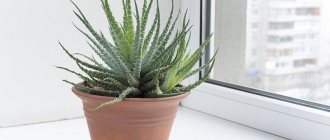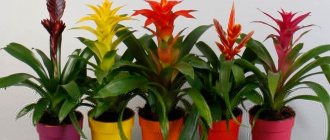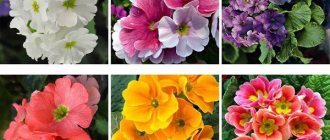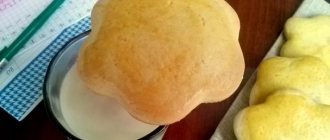In the wild, the Guzmania flower grows on mountain slopes. It was brought from America. Guzmania (guzmania) is a cultivated plant. Represents the Bromeliad family. Its main features are narrow leaves of significant length, they form a rosette in the center, and here a bright flower of different shades appears (red is more common).
Various types of plants are grown at home (Guzmania mix is common). Compared to the mountain version, cultivated flowers are more compact - they do not exceed 40 cm in height. Caring for them involves watering, feeding, and organizing lighting.
Useful properties of guzmania
In the wild, the plant serves as a source of moisture for small creatures, which is due to the structure of the leaves - they are distinguished by their funnel-shaped shape, where drops of rain and dew accumulate. This same property allows the flower to use as much water as is necessary for normal development.
In addition, guzmania helps purify the air. It is also believed that it harmonizes the surrounding space.
Diseases, pests and methods of combating them
The tropical beauty is susceptible not only to attack from pests. It is also at risk of fungus, white limescale and root rot. The most common pests are spider mites, mealybugs, and scale insects.
Guzmania diseases
Mealybug is a pest that lives in the root zone and at the base of foliage. By damaging the leaves, the mealybug causes the appearance of sooty fungus. As a result of the damage, the leaves may turn yellow and growth may be stunted. To combat it, it is recommended:
- wipe the leaves on both sides with a sponge dipped in a solution of laundry soap,
- water the soil with pest repellents.
Scale insects attack leaves on both sides. Externally it resembles dark tubercles. Leaves affected by scale insects turn yellow and die. For treatment you need:
- remove pests with a sponge soaked in Actellik solution;
- spray the plants with a solution of this drug;
- water with insecticide solution.
Shchitovka
Signs of spider mites include yellow spots on the leaves. Affected leaves turn yellow and die. The fight against the parasite includes treating the leaves with a soap solution followed by spraying with an insecticide - Oberon, Sunmite.
Brief description of cultivation
Basic requirements for flower maintenance:
- lighting: diffused, high brightness;
- moderate watering: you need to navigate by the drying speed of the surface layer of soil;
- Temperature fluctuations are allowed, but within the limits: +15°…+27°С;
- air humidity is maintained at a high level;
- feeding frequency: monthly (once), special formulations are used, but the concentration of the solution should be half that recommended by the manufacturer.
How care is organized at home
The plant has a long flowering period - up to six months. In order for guzmania to decorate your home, proper care should be provided. At home, a number of environmental parameters are simultaneously controlled, soil and flowerpot are selected. Replanting is not required if the pot size was initially selected correctly.
Moisturizing leaves (spraying)
One of the conditions for normal plant development is high air humidity (up to 85%). If at home the value of this parameter does not correspond to the required value, it is increased artificially. To do this, follow these steps:
- Spraying is carried out if the guzmania has not yet bloomed; drops should not be allowed to fall on the flower;
- remove the pot from the windowsill;
- Place water in pots nearby;
- Sphagnum is placed on the ground.
Tip: Use filtered, distilled water for irrigation.
How to water
Do not moisten the soil according to schedule - the liquid will stagnate. You need to be guided by the speed of soil drying. Additionally, water is poured into the rosette of leaves once a week. When the room temperature drops to the minimum limit (+18°C), the liquid is poured out of the funnels, otherwise the flower will rot.
Tip: Settled or rainwater is used for irrigation. The recommended temperature is 2-3°C above room temperature.
Choosing a pot
Guzmania stands out for its weighty leaves. This makes the plant heavier. Accordingly, select a pot with thick walls. A ceramic option is suitable.
Considering the height of the plant, you should choose a small pot. An option is often selected with a diameter that corresponds to the size of the root system (it is underdeveloped) - up to 12 cm. But it is better to immediately plant larger flowers in wide pots.
Priming
Main requirements: the soil is loose and loose. The flower develops well in soil intended for bromeliads.
Guzmania can also grow in substrate prepared independently. The base is often leafy soil. It is taken in equal shares with other components.
Options:
- universal soil, crushed pine bark and sand - take equal parts;
- leaf soil and coconut fibers - equal parts, and sphagnum, mineral component (sand) and pine bark - 1/2 part each.
Be sure to form a drainage layer at the bottom. For such a plant, the pot is filled 1/3 full.
The video below also talks about one of the soil options for planting a flower:
Fertilizer recommendations
The main purpose of fertilizing is to create conditions for the appearance of a peduncle and to increase the duration of the flowering period. For the purpose of fertilizing plants, they use compositions intended for bromeliads, but mixtures are also used for orchids.
Guzmania is fed only in warm months. But care involves applying fertilizers in a special way - into an outlet.
Where to put the pot: lighting arrangement
In winter, guzmania is moved closer to the source of the sun - to the south side of the apartment. In the summer they change the location, the flower is placed next to the windows that face the western and eastern sides.
Care will provide the desired result if the guzmania is not placed directly in the sun. For this reason, on the south side of the apartment the pot is placed at a distance of 1 meter from the window. The flower loves diffused light.
Suitable temperature
Home care involves creating a comfortable microclimate. The air temperature is maintained at +20°…+25°C in summer.
In winter, other conditions are created for the plant: the value of this parameter is reduced to +18°C. The upper limit of the range of permissible values corresponds to +27°C.
Subtleties of plant transplantation
The flowerpot is changed in a number of cases:
- the soil became sour, the flower began to die;
- the pot became small;
- After flowering, guzmania gradually dies; home care includes separating the young sprout (babies).
Transplantation is performed after purchase. When the plant acclimatizes to new conditions, change the container to a larger one and fill it with nutritious soil.
Another method of transplantation, but not in the ground, but on a tree:
Guzmania transplant after purchase
How to transplant Guzmania photo
It is better to immediately transplant the purchased plant into a beautiful, spacious pot with prepared nutritious soil; read more about the composition of the soil below. Transplantation is carried out using the transshipment method: water the soil and leave for several hours until it becomes limp. Afterwards, carefully release the earthen lump from the pot, trying not to disturb its integrity.
Lay out a drainage layer of expanded clay, cover the soil with a layer of several centimeters, install the guzmania vertically, and fill the side space with soil. Water carefully. If the ground has subsided, it is filled up to the original level.
Reproduction methods
Available options:
- dividing the bush;
- application of seeds.
The first option is most often used. It is much easier to implement, especially if you already have a flower at home.
Seating rules
You can transplant it into a separate pot when the baby has roots (at least 1 cm). Before this, the cut must be protected with garden varnish. If you plan to plant several sprouts, you should keep in mind that not all develop in the same way. You can speed up the appearance of roots if you bury the baby in the bark. The video below shows how you can separate the babies:
Propagation of Guzmania by seeds
The process of development of sprouts is longer than propagation by dividing the bush (using the planting method).
Recommendations:
- prepare a container with a substrate suitable for growing guzmania;
- the seeds are treated with a weak pink solution (based on potassium permanganate);
- dried;
- laid out on the ground (but not deepened);
- Watering is carried out periodically - the seeds are irrigated from a spray bottle;
- cover the container with film;
- recommended air temperature – up to +24°C.
The first shoots should be expected in 2-3 weeks.
Growing guzmania from seeds
Guzmania seeds photo
Before sowing, it is good to soak the seeds in a pink solution of potassium permanganate for 10-15 minutes and dry until they flow. The procedure is a prevention of rot and other diseases.
- Scatter Guzmania seeds as little as possible on the surface of the ground and press with your palm.
- The soil for planting seeds consists of a mixture of sand and peat in equal parts.
- After sowing, the soil is sprayed with a spray bottle and the container is covered with a plastic bag.
- Maintain high humidity and temperature within 25 °C.
- Three weeks later you will be able to see the seedlings, you will definitely need to ventilate, and later remove the shelter completely so that the plants do not get sick.
- For about a month, green seedlings will grow and will need to be picked into separate cups. It is better to take larger containers, approximately 7 cm in diameter, to give more space to young seedlings.
In the future, care is similar to care for adult plants. When the plants grow up, they are simply transplanted into permanent pots using the transfer method. After two to three years, flowering can be expected.
Possible problems
If flower care is insufficient, the plant exhibits the following characteristics:
- when humidity is high, fungus develops;
- when there is a lot of sun, brown spots appear;
- dry air causes leaf tips to change color;
- yellow spots, cobwebs – signs of tick infestation;
- light fluff is a symptom of the appearance of a mealy worm;
- white tubercles are formed due to infection with scale insects;
- soft leaves (transparent in the light) are a sign of exposure to low temperatures.
Where to put according to Feng Shui?
Married couples can safely place two pots of plants in the bedroom . They say that this way you can attract variety into intimate relationships, making them more passionate and romantic . Just place the pots opposite each other. Why exactly two pots? This is explained very simply - two plants symbolize relationships in a couple .
By placing a flower in the living room, you can attract material wealth to the family . A pot in the kitchen will fill the house with comfort and harmony .
According to the teachings of Feng Shui, the cardinal directions play an important role. Do you want the plant to have a beneficial effect on love and family relationships? Then place it on the southeast side .
Donell-Smith's Guzmania
Located in the east, it will be responsible for health and creativity .
Reference! Guzmania, which blooms with bright red or rich orange flowers, will help fight stress and get rid of depression . Guzmania with bright yellow sultans will attract prosperity and success to the house.
Guzmania Bolero
Types of Guzmania
There are different varieties of plants: Guzmania mix, Minor, reed, etc. In each case, the care is different. The flowers also differ in appearance. Meet some of them.
Tongue
Leaves are rich green. The flower is red, the plant reaches almost half a meter in height. It needs to be watered several times a week, caring for this type of guzmania is not difficult: there is a need for fertilizers during the growth period, humidity is from 60%, air temperature is within +18°...+25°C.
Donnell-Smith
The leaves are green (a lighter shade than other varieties), up to 60 cm long, wide. Peduncle straight. If such guzmania is grown, care is simple. This is a self-pollinating plant. Flowering begins in late spring.
Blood red
It is distinguished by its small size - height up to 20 cm. On the leaves you can see a bright coating of red/yellow hue. When such guzmania is chosen, home care will include all the main principles described above. The peduncle is missing.
Musaika (mosaic)
It is distinguished by an unusual leaf pattern: green, with transverse stripes in the middle. The peduncle is straight, red with pointed stipules, and the flowers are yellow. When such guzmania is purchased, care at home is carried out according to the standard scheme: high air humidity is ensured, watering is moderate, fertilizer is applied in spring, summer and autumn.
Nicaraguan
The leaves are lighter in color and taper towards the top. The inflorescence is red, goblet-shaped. Yellow flowers appear on it. This usually happens in March.
Single-haired
The main difference is the white flowers. They develop on a long straight spike. Bracts are red. As a result, the appearance of the plant is more vibrant, as multi-colored inflorescences appear against the background of rich green leaves.
Tsana (Zana)
This is a large plant. It is distinguished by the unusual color of the leaves - they are green, with a light stripe running down the center. The peduncle is large, straight. The flower is yellow.
Why doesn't Guzmania bloom?
A fairly popular question that worries every second, or even first, owner of a flower. This is not surprising, because Guzmania grows very slowly - within 3-5 years. Sometimes it seems that time has frozen around her, she lives so leisurely. You need to get used to this and learn to wait if the flower is still young.
But there are other reasons why guzmania does not bloom:
- flower diseases;
- low illumination;
- lack of moisture;
- soil poor in nutrients;
- excessive dry air;
- lack of heat.
In other words, flowering does not occur due to insufficiently comfortable conditions. It is necessary to reconsider the features of care, and perhaps simply move the plant to another place or room. Finally, the last reason why guzmania does not bloom is its old age. Some unscrupulous sellers may sell new gardeners a plant that has already bloomed once. A long lifespan is indicated by a loose rosette and possibly trimmed lower leaves.
How to stimulate flowering?
Of course, the most proven and safest way to make guzmania bloom is to follow the rules of care. To check the temperature and humidity, you should use a hygrometer and thermometer, because the assessment “by eye” is often erroneous. If the conditions for the plant are ideal, but there is still no flower, you can try original methods of stimulation.
Here are the recipes experienced flower growers share:
- Larisa, 33 years old: “I have had several generations of guzmanias. If some baby doesn’t bloom for a long time, I take a large transparent plastic bag, put 3 small ripe apples (maybe a little rotten) in it, wrap the pot and tie it tightly for several hours. After about 2 weeks of manipulation, the growth point begins to turn pink. That’s what the seller advised me, it seems like apples emit a substance called ethylene, which guzmania needs to bloom.”
- Vitaly: “I can advise you to transplant the flower into another pot, completely changing the soil. After this, you need to spray the leaves with Epin. Personally, this helped my guzmania; before this it had not bloomed for 6 years.”
- Maria, 47 years old: “I heard that this bromeliad needs 2 months of cool weather, +7–10 degrees, to bloom. But I didn’t take that risk, and simply took the guzmania out onto the balcony in early April. At the end of May, she brought it back, and lo and behold, on the 5th day she threw out the peduncle.”
- Vera Stepanovna: “In my flower garden I have vriesia, echmea and gusmania. They bloom only in summer, when the temperature remains stable at 25 degrees. If the room is cooler, try using a greenhouse or placing the pot in an aquarium.”
In conclusion, Guzmania at home looks like a real island of exoticism. Despite the specific nuances of care that need to be learned, it is easy to maintain. Once you have chosen the right place for it (warm, light and moist), care can be limited to filling the outlet with water as it dries.
Let's summarize
Thus, guzmania care is carried out taking into account the rules: high humidity is maintained from 60 to 80%, watering is controlled, since the leaves are additionally irrigated with water, and moisture accumulates in the rosettes. Use special soil and fertilizers.
It is important to replant shoots on time. Propagation by seeds is rarely done. This method is used when you need to take seed material of a plant you like, for example, from friends/acquaintances. If guzmania is chosen for cultivation, the varieties can be different - with flowers of different shades.
Possible diseases
If you overwater the plant, this may cause fungi to appear and the roots may rot. You should immediately stop watering and add water little by little to the rosette of long leaves.
The plant is susceptible to spider mites and mealybugs. To save the plant, you need to treat the damaged leaves with a soap solution. You can also spray the beauty with a special remedy against various pests.
Luxurious guzmania is a decoration for any apartment (house). Knowing the peculiarities of watering and how to transplant guzmania, you can enjoy the beauty of the exotic plant for many years. Some people will like a yellow flower, others - purple or rose-red.
Below is a photo of guzmania of different varieties and shades of peduncle.
Popular articles Boiling porcini mushrooms before frying: is it necessary and how to do it correctly











